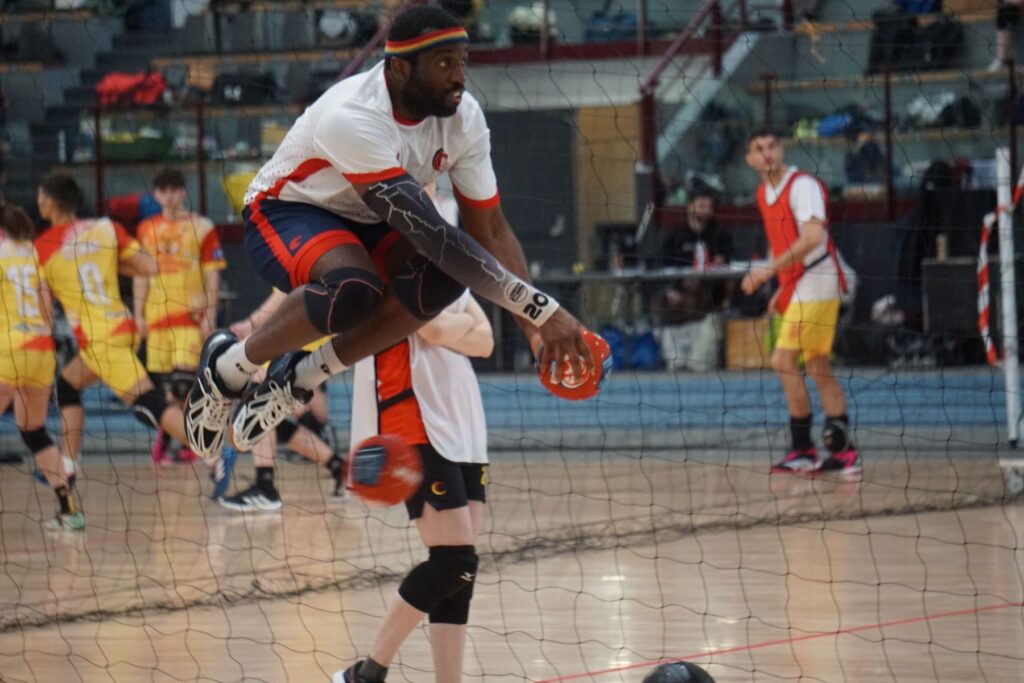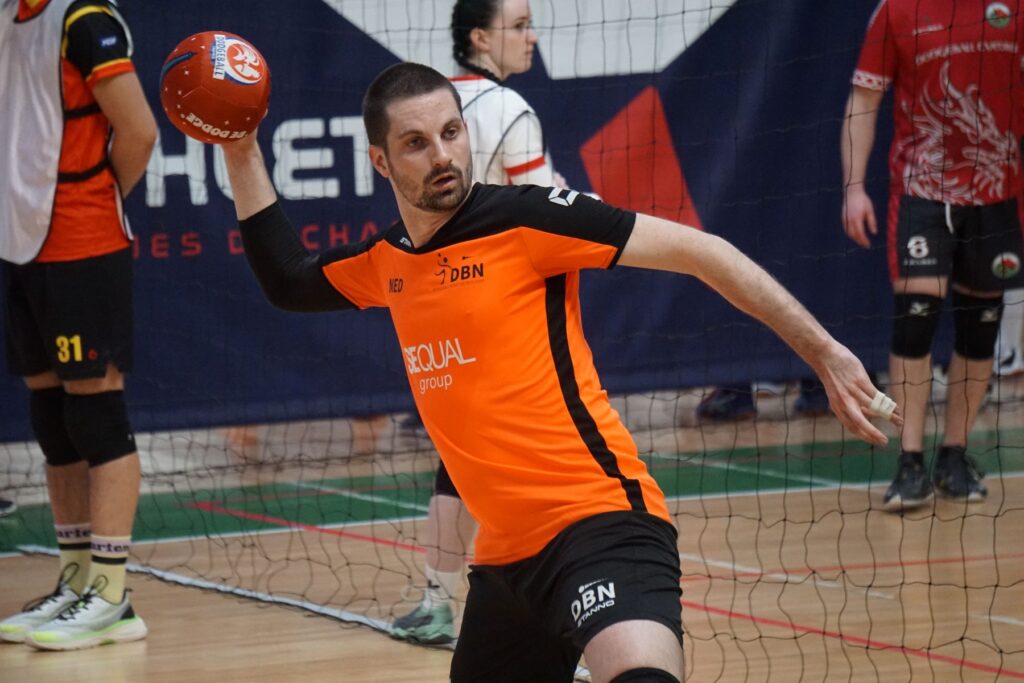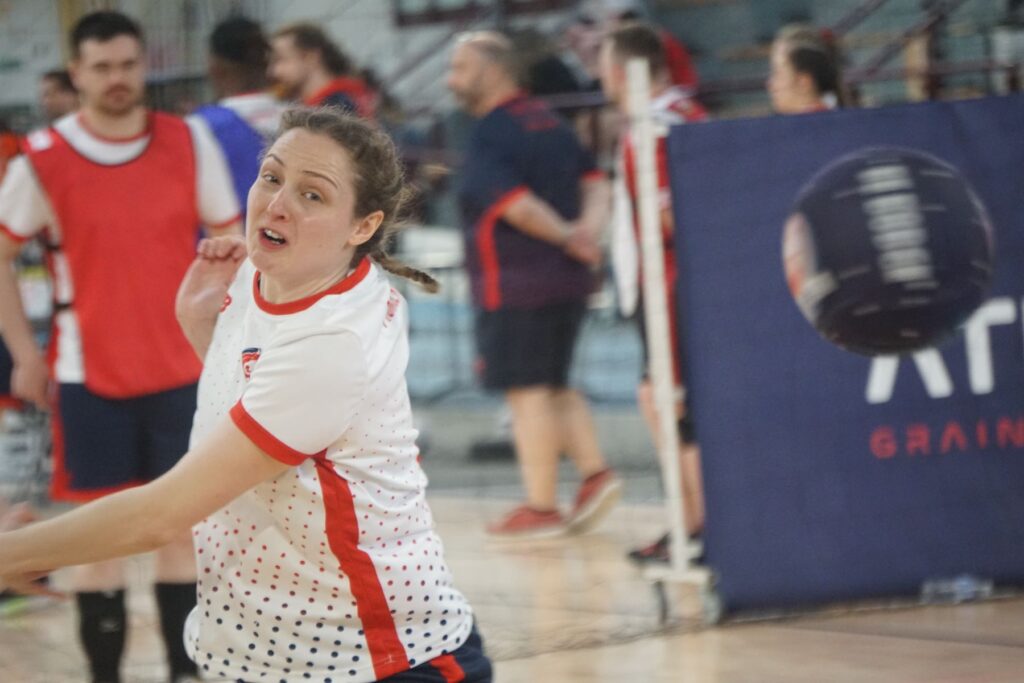With a high, athletic jump, Steve Ndumbe dodges the clothball fired at him. The ball passes under him without hitting him. After landing, the England player immediately sprints forward with a ball that he already had in his hand (one of five others in play at the same time) to hit an opponent with it and throw him out. And a moment later he’s out of the set himself, after a dull bang of the ball on his imposing body.

Dodgeball is a sport in which you attack and defend at the same time. In which you are always hunter and prey at the same time. At the Western European Championship in the French town of Eaubonne, just above Paris, seven countries with multiple teams in multiple categories (men, women, mixed) competed for the medals. England came first and second in all three categories. Not surprising given the number of people who practice the sport in England. With more than 1,600 official players and more than 80 competitive clubs, this is much higher than any other European country.
University
Karen Pickering, with her 31 years one of the more experienced players in the English teams, about the relative popularity of the sport in England: “I think it’s because our university set-up why dodgeball is popular among students. Most people may have done other sports in the past and find in dodgeball the social and fun part of sports. They form a club and from there it’s starting to become more serious.” In that same way Pickering’s dodgeball career evolved. She started at the University of Birmingham, played for the national team of Wales at first and is now one of the key players for England. “In Birmingham it was the first year of the club at uni, I just played for fun and didn’t think anything of it and yet here I am, some 13 years later!”
Five balls, cloth and foam
The purpose of dodgeball is to throw out your opponents. There are five balls in the game. A player on the pitch indicates whether he or she has been hit, because the two referees cannot see everything. Each team consists of six players. In two halfs of twenty minutes, different sets of up to three minutes are played. A set is won if all six opponents are thrown out (for 2 points) or if you have more players in the field after those three minutes (for one point). In the United States, a different form of dodgeball is played, with a softer foam ball. The rules also deviate slightly. For a solid and very informative story about the history and the development of the sport and the differences between the variants in dodgeball, we would like to refer you to (you’re one click away to discover the connection of dodgeball with the ancient Greeks and actor Ben Stiller):
https://www.houseofdodge.co.uk/blogs/news/dodgeball-the-story-so-far
In most countries the story of dodgeball follows a similar pattern: played it as a kid in (high) school and then it fizzles out. If dodgeball players tell other people they play dodgeball at a club, the most likely reaction they get is the following: ‘Oh, I didn’t know that was a real sport, I played it in school.’
Dylan Bravo, a 27 years old half Canadian, half Dutch player who grew up in the United States in Darien, Connecticut: “In that small village, I played it as kid, I was about six years old I guess, with a small, sort of woolen ball. At high school we played with the foam ball in stead of cloth ball, that’s the variant that is played in the US, but it was just for fun. Sometimes with thirty students on the pitch at the same time. And when I came to Delft in the Netherlands to study civil engineering, I didn’t think I’d be playing dodgeball again!”

But after Bravo joined the so called tickethour, where students can get to know different sports or cultural expressions, a small group of people were that enthusiastic they formed the club Delftsche Dodgers.
Spectacular sport
Every dodgeball player mentions the same characteristics to indicate why it is a great sport: sportsmanship, the sense of community and speed. Austrian world champion Catrin Weber (34), MVP of the World Cup in Canada in 2022: “It really is a spectacular sport, there is always something happening. Constantly moving, diving, throwing, it’s really fun to watch.”
Weber, a tactically strong player and coach, is also a member of the rules committee of the EDF, the European Dodgeball Federation: “As an organized sport, it is a young sport that is developing, so we also occasionally adjust the rules of the game. And tactics are important. When do I go for a dodge or a catch or maybe I even try to throw next to somebody, deliberately. You can chose to do so if you lead and you don’t want to risk your opponent catches your ball. But you have to throw within a meter of somebody, otherwise you are out.”
A clothball gives a loud bang if it crashes into the body of dodgeball player. But if it doesn’t land on fingers, the tough dodgeball athletes don’t blink. By the way, it is sometimes better to place a ball carefully instead of throwing it hard.

Karen Pickering: “If you throw really hard at someone’s gut, it forms a nice pocket to catch. If you place it on shoulders or toes, they can’t catch it.” She refers to former captain of the squad Charlotte Josiah, one of the best catchers in dodgeball. “Sometimes just the name or presence of the player intimidates the opponent. Charlotte is such a good catcher, some of the throwers of the opposing team know they’ll be out before they throw.”
There are tentative Olympic dreams, but to make that come true, the sport will have to (a) be played in more countries and (b) attract a larger audience. In Eaubonne there were some good developments in both areas. Portugal was there for the first time, with two men’s teams (Portugal 1 finished sixth). There are more countries that could join in the coming years. Frank Broy, who now plays for the Netherlands, also has the Luxembourg nationality and wants to try to develop dodgeball in that country.
And the main matches were streamed live, with commentary of specialists. “We are going the right way with the live streams,” says Pickering. “We need to get people interested. Now, the crowd in the stands are friends, family and people who are already into the sport. With live streams we can maybe get some sponsorship deals and we can lift the sport to another level.” Because for now: apart from some sponsorship deals for outfits or individual crowdfunding, no one gets paid. Not the players, not the commentators, not the organizers. It’s all for the love of dodgeball.